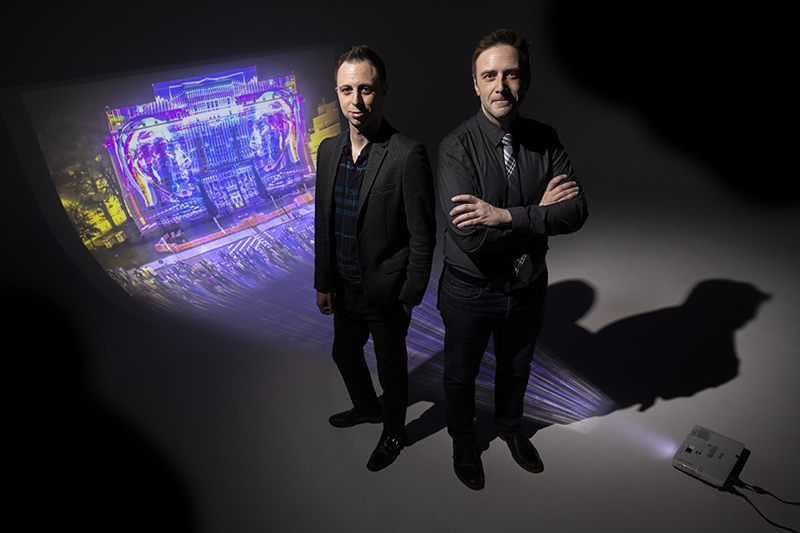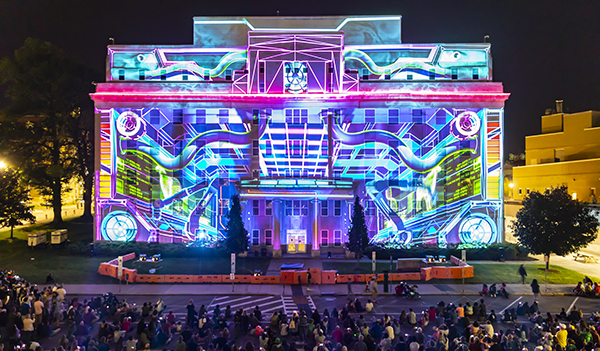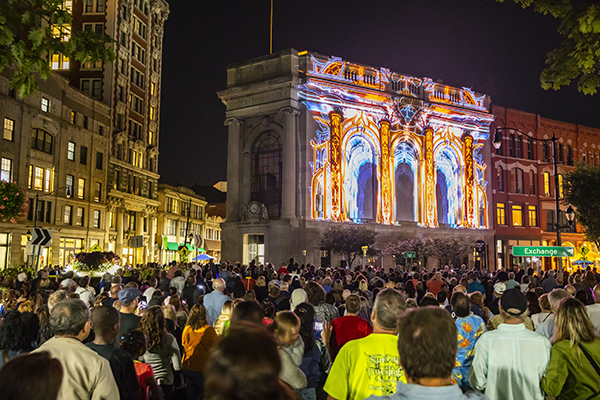LUMA builds magic
Festival lights up downtown Binghamton with projection mapping technology

You’re looking at an ordinary office building when suddenly the exterior takes on the gritty texture of sand. Before your eyes have time to adjust, the sand is swept away and the structure is submerged in water. And just when you thought you’d seen it all, the building implodes, flames burst from the facade and a giant Medusa head stares back at you.
No, you’re not losing your mind. Nor is the world descending into some kind of phantasmagoric chaos. You’re witnessing an illusion, a 3D animation projected onto a building.
This particular animation, titled “Pandora’s Box,” is one of many that has been featured in the LUMA Projection Arts Festival, held each fall in downtown Binghamton. Co-founded by Joshua B. Ludzki, MBA ’13, and Tice Lerner, LUMA has become a popular area event, attended annually by tens of thousands, entertaining community members and international visitors alike. 2020 marks the festival’s sixth anniversary. The show is planned for Sept. 10-12.
In an age where it’s possible to stream movie theater-level entertainment from your living room, LUMA offers something truly special, Ludzki says.
“We’re so used to steaming high-end special effects and great sound in our homes that the experience of going to a movie theater isn’t as exciting as it maybe once was,” he says. “That’s not true of seeing LUMA, which is unlike anything you can produce at home. The experience of seeing it with thousands of other people, where everybody experiences the same sort of delight and excitement at the same time as the story unfolds in front of them 10 stories high — it’s unlike any other.”
First-of-its-kind festival
Ludzki moved to Binghamton in the early 2000s for a job in radio. He didn’t plan on staying long-term, but he fell in love with the area. It wasn’t long before he was promoting local events, such as Restaurant Week, Masquerade at the Mansion and the Martini Walk. These were successful, but he wanted to extend tourism outside the area.
Enter projection mapping. Ludzki had become intrigued by the technology and asked Lerner if he knew anything about it. For Lerner, whose professional career revolves around eye-catching visuals — he’s a photographer and designs effects for film and television — the concept was appealing.
“I’ve always had this interest in creating tangible illusions, things that shouldn’t exist in reality but, even if it’s just for a second, can create childlike wonder in an adult,” Lerner says. “That’s the magic of filmmaking, virtual reality and video games. How can you take that to the next level? How can you take a digital asset and make that seem physically tangible? That’s what projection mapping is to me.”
Lerner and Ludzki quickly found that, while projection mapping was gaining traction in Europe and Australia, there weren’t many people doing it in the United States — and no one had created an all-out festival around the concept.
“We initially went online to look for tutorials on projection mapping and pretty quickly discovered that, in certain ways, it’s still kind of a proprietary, closely guarded secret,” Ludzki says. “Our attitude essentially was, ‘This is kind of great. If we can figure out how to do it, we’ll be one of the few in the U.S. to kind of know the art.’”
Organizing a new festival is hard enough, let alone one based on an esoteric concept like projection mapping. To get a feeling for the technology, they started by projecting art onto a surface slightly smaller than a building: Ludzki’s kitchen cabinets.
The first festival, held in 2015, came with a steep learning curve. They initially wanted to include eight features, but scaled it back to five. And thanks to a mix-up with the projection rental company, they were unable to have a full rehearsal the night before the event. But they still made it work.
“Given the dedication, focus and seriousness of our team, we were literally able to align and test the projections the day of, just a few minutes before our official public performance,” Ludzki says.
Like the Macy’s Parade
Ludzki and Lerner have streamlined the process over the years. As soon as the festival is over, they’re loading up the truck and already having conversations about next year’s event.
“It’s not unlike other big events like the Macy’s (Thanksgiving) Day Parade, where you’re running right out of the gate as soon as it’s over,” Ludzki says. “Our process has become increasingly more scheduled, regimented and professional as we’ve gone on.”
The team is already talking to artists, planning contracts, signing back sponsors, assembling teams and figuring out logistics as early as January. Team members meet regularly throughout the year, with monthly meetings kicking off in the spring; by late summer, they meet weekly. And instead of one night of rehearsal, they now take the entire week in advance of LUMA to ensure that everything is perfect.
Built by Binghamton
While Ludzki and Lerner spend countless hours making LUMA work, they are quick to point out that the festival has never been a two-man operation. LUMA was built by Binghamton.
“There’s no way in the world that this would exist without hundreds, if not thousands, of other people contributing in their own ways,” Ludzki says. “Everything from pitching in 20 bucks to buy a T-shirt when we have our annual fundraiser, to small businesses sponsoring the event, to government officials who bend over backwards to make all of this work, to Department of Public Works employees who work extra hours to make sure downtown can accommodate all of those new people who are coming to visit.”
That local talent pool has featured Binghamton University students, including engineering majors Paul Tilley, Johnathon Van-Atta ’19 and Madison Werner, who, in 2019, helped to program retro-style video games that were beamed onto a building and playable by LUMA attendees.
For Werner, it was surreal seeing her hard work come to fruition.
“Attending meetings for months, discussing site diagrams and other event practicalities, normalizes and trivializes the process of actually designing these projections,” she says. “I fully believed that I understood the significance of what we were doing until I stood in front of the projection.”
Making an impression
LUMA has not only impressed everyday citizens, it’s drawn attention from major businesses and organizations. Along with a partnership with Panasonic, LUMA teamed up with the United States Institute for Theatre Technology (USITT) in 2019 to host a new digital media symposium right in Binghamton. USITT brought in top experts in the theater production field, including Finn Ross, a production designer for Broadway shows like Harry Potter and the Cursed Child and Frozen.
Kari Bayait ’08, marketing manager for Binghamton University’s Theatre Department, developed programming for the symposium. In addition to getting art and design students involved, she organized a series of educational talks utilizing faculty like the Music Department’s Paul Schleuse and notable anthropologist Distinguished Professor David Sloan Wilson.
“We have this great intellectual community to draw from. Why not bring in some people from the University campus and integrate them into the program?” Bayait says.
Looking forward
Ludzki and Lerner have reached a point where planning LUMA is manageable, but they’re not resting on their laurels. They want the festival to keep growing.
“Projection mapping is a storytelling media,” Lerner says. “Artistically, how do you take that to the next level, to something that isn’t just a quick spectacle — something you can take home and think about later on?”
Ludzki hopes that everyone in the Binghamton region has the chance to see LUMA firsthand come autumn. YouTube videos are great, but you have to see it in person.
“Sitting at home streaming it on your TV is not the same experience,” Ludzki says. “You really do have to come together as a community member, in a crowd with thousands of other people, to experience what LUMA is like. To experience the scale of it, the wonder of it.”



